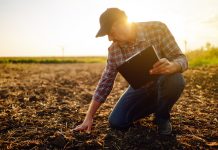David Green, Executive Director at U.S. Sustainability Alliance and a commentator and advisor on food and agriculture for GreenOrange, comments on sustainable food. It’s a common goal but how do we get there?
Mark the date 29th April 2021, which could well become a watershed moment for European food production. A European Commission study published that day acknowledged that gene editing techniques could contribute to sustainable food systems with plants more resistant to diseases, environmental and climate change effects.
It went further, stating that while some commentators branded such techniques unethical, “missing opportunities as a result of not using them” is equally unethical. The study also states that gene editing will contribute to “the EU’s objectives of innovation and sustainability of food systems, as well as a more competitive economy, [and] can have benefits for many sectors of our societies.”
This much-anticipated study displays a welcome sense by the Commission of the reality facing the global drive to sustainable food production. It comes against a decades-long European landscape of rejection of, if not hostility to, anything linked to food and genetic engineering. For sure, the debate on following through on the Commission’s study will be lengthy on both sides.
However, the playing field has been mapped out in a way that recognises what is happening across the world. Many countries are looking to gene editing to improve plant breeding through editing a plant’s own DNA without the insertion of external genes such as those used in genetic modification. As such, these countries are not seeking to regulate gene editing in the manner applied to genetically modified crops.
A light touch
North and South America take a ‘light’ regulatory approach to gene editing. In Argentina and Brazil, a technology company wishing to commercialise a gene edited plant must request an opinion from its government’s agriculture department as to whether it constitutes a new combination of genetic material. If the view is that it does not, the company is not required to make an application for authorisation through its country’s GMO regulatory procedure.
In 2020, the U.S. Department of Agriculture (USDA) finalised a rule which may exempt (i.e., does not regulate) some gene-edited plants from existing U.S. GMO regulations. Developers can request confirmation from the USDA’s Animal and Plant Health Inspection Service (APHIS) that an edited modified plant qualifies for an exemption. APHIS will provide written confirmation of the plant’s status within 120 days.
Common objectives, a different approach
Despite differences in the adoption of some production technologies, the U.S. and the EU have much in common on sustainable food objectives. The monumental challenge for both sides and the rest of the world, is how to grow more food on less land, using fewer inputs, respecting water quality and quantity, improving soil health and working to mitigate climate change.
To feed the 10 billion people expected by 2050, the world’s food systems must produce more food over the next twenty-nine harvests than has been produced in the last 10,000 years. Which way will best meet this challenge – a U.S.-style approach focusing on innovation and new technologies or the EU’s ambitious, technology-light Farm to Fork (F2F) strategy with aspirational goals such as a 50% cut in chemicals and conversion of 25% of its farmland to organic by 2030?
F2F: U.S. perspective
Generally, in the U.S. there is an understanding that the EU’s F2F strategy is commendable and has a shared goal of a safe, sustainable food supply. But some American observers also foresee that implementing some of the F2F goals that are not internationally recognised or scientifically supported will be likely to create trade barriers.
To understand some of the implications of the F2F practicality, the USDA’s Economic Research Service carried out an impact assessment which noted that the F2F’s proposed input reductions would cut EU farm production by up to 12% and diminish farmers’ competitiveness. No such impact study has yet been carried out by EU agencies and farmers there are worried about losing access to chemicals and innovative technologies.
On 20th May, a group of 29 major EU food and farming organisations called for a “proper impact assessment” of the F2F strategy, and a debate based on concrete data and scientific evidence. The group argues that F2F should be in line with the EU’s “better regulation principles, not [based] on ideology and political stances”. It believes that F2F will not fulfil its initial ambitions and could negatively impact production capacity, competitiveness, imports and consumer prices.
The case for science
While U.S. food and farm organisations acknowledge that the overall F2F goals might be laudable, the question is can, and how, will they be delivered? How to produce enough food from a global shrinking of farmable land? Can this be done without adopting promising technologies (including biotechnology)? The Commission’s study on gene editing points to an agreeable appreciation of the role science-based, risk[1]based, technology-driven agriculture can play in sustainable production and helping to meet the needs of 2050. The F2F strategy concludes that it aims to “make the EU food system a global standard for sustainability”.
At best this ignores the fact that different world regions have different production systems and thereby approaches to sustainability. This is not to say one system is better than another – but more that they can be based on different geographic, climate and cultural aspects from Europe. One size will not fit all and on the path to a sustainable food future, then all roads can lead to Rome.
More on the Farm to Fork Strategy
In our April 2021 online publication, Claire Bury, Deputy Director-General for Health and Food Safety at the European Commission, walked us through the Farm to Fork strategy about the transition to more sustainable & healthier food. In this piece, Claire explains that Farm to Fork, one of the main components of the Green Deal, is a “driving force
for sustainability”.
She added that when the pandemic entered our lives, it impacted us significantly and had “ramifications for many sectors – including the EU’s farming sector and food industry.” Certainly, the Farm to Fork Strategy aims to transform the EU food system by 2030 and alongside the Biodiversity strategy, it contributes to greener food production. These comments were echoed by European Commissioner for Health, Stella Kyriakides, earlier this year who said that in May 2020 the Commission heralded its Farm to Fork Strategy as a crucial aspect of the European Green Deal.
“The Strategy outlined a vision to transform the way we produce, market, distribute and consume food,” she said. “Food safety and trust in the EU food safety system provide the foundations for a more sustainable food system,” Commissioner Kyriakides added.
Going back to Claire Bury’s recent article for us, one interesting takeaway from that concerns a survey that tells us European citizens expect much from the EU when it comes to food. “Most of them believe that producers (farmers, fisheries, etc.) and food manufacturers are key actors in making our food systems sustainable,” Claire explained.
“Through the Farm to Fork Strategy, we have laid down the foundation for creating a better, stronger and fairer food system,” Claire concluded.











